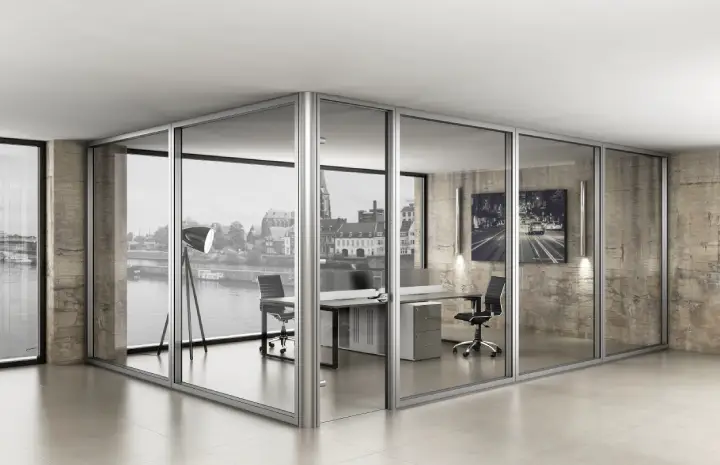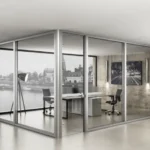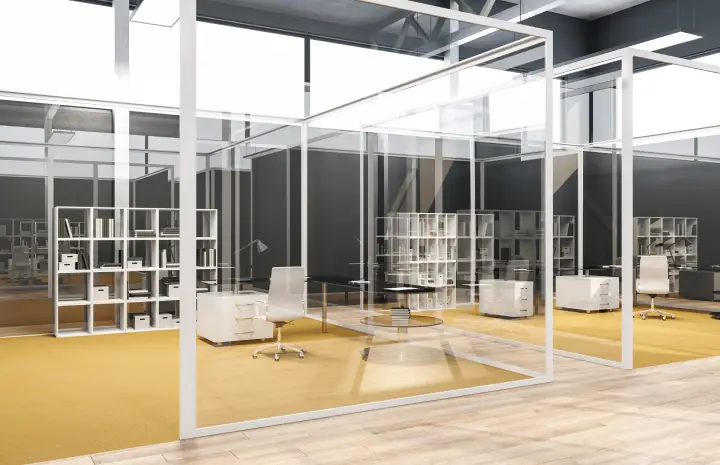Sustainable Materials in Office Sliding Glass Partition Systems
As sustainable design becomes the defining trend in architecture, interior designers and facility planners are increasingly turning their focus toward greener solutions. Among the most transformative innovations in workspace architecture are Office Sliding Glass Partition Systems — elegant, adaptable, and now, remarkably sustainable.
Once viewed purely as aesthetic upgrades, sliding glass partitions are now engineered with eco-friendly materials that promote energy efficiency, reduce waste, and enhance long-term performance. From recycled aluminum frames to low-emission glass, these systems embody the balance between modern aesthetics and environmental responsibility.
This comprehensive guide explores the sustainable materials, manufacturing practices, and design strategies that make today’s Office Sliding Glass Partition Systems the centerpiece of green office design.
Why Sustainability Matters in Office Design
Modern workspaces are no longer judged solely by their visual appeal — sustainability and employee well-being are equally essential. As more businesses adopt green building certifications like LEED, BREEAM, and WELL, interior systems must align with environmental standards.
Sliding glass partitions play a key role by:
- Maximizing natural light and reducing artificial lighting costs.
- Enhancing indoor air quality through non-toxic finishes.
- Supporting modular reuse, minimizing demolition waste.
- Improving thermal performance and energy efficiency.
Integrating sustainable materials into these partitions not only reduces a building’s carbon footprint but also promotes a healthier, more productive workplace.
Sustainable Glass Options
Glass is the defining element of Office Sliding Glass Partition Systems, and sustainable innovation has transformed how it’s produced and used.
1. Low-Emissivity (Low-E) Glass
Low-E coatings reflect heat while allowing visible light to pass through, maintaining thermal balance. In warm climates, this reduces cooling loads, while in colder regions, it minimizes heat loss.
2. Recycled Glass
Modern glass manufacturers are increasingly using cullet — crushed recycled glass — to produce new panels. This reduces energy use in furnaces and lowers CO₂ emissions.
3. Tempered and Laminated Safety Glass
Sustainable doesn’t mean fragile. These glasses are built for durability, meaning fewer replacements over time — a major factor in lifecycle sustainability.
4. Smart Switchable Glass
Electrochromic or PDLC (Polymer Dispersed Liquid Crystal) glass allows instant privacy control with minimal energy use. It eliminates the need for blinds or curtains, simplifying maintenance and improving energy efficiency.
By selecting these advanced materials, architects can ensure that Office Sliding Glass Partition Systems meet both design and sustainability goals.
Eco-Friendly Frame Materials
While glass takes the spotlight, the supporting frame and track systems play a crucial structural and environmental role. Sustainable framing materials reduce embodied carbon and enhance recyclability.
1. Recycled Aluminum
Aluminum is one of the most sustainable metals on earth, capable of infinite recycling without quality loss. Using recycled aluminum frames can reduce energy consumption by up to 95% compared to producing new aluminum.
2. Steel with Recycled Content
Some partition manufacturers now use high-strength, recycled steel to create thinner profiles, reducing material volume while maintaining rigidity.
3. FSC-Certified Timber Accents
For offices blending natural textures with transparency, certified timber trims or frames sourced from sustainable forests add warmth without compromising environmental ethics.
4. Powder-Coated Finishes
Traditional paint processes emit volatile organic compounds (VOCs). Powder coating is a sustainable alternative — VOC-free, durable, and available in diverse finishes to match interior design schemes.
By integrating these materials, Office Sliding Glass Partition Systems become not just functional dividers, but active contributors to sustainable architecture.
Sustainable Hardware and Accessories
Sustainability extends beyond panels and frames — it includes the moving parts that ensure performance and longevity.
- Stainless Steel Hardware:
Long-lasting, corrosion-resistant, and fully recyclable, stainless steel supports durability in high-use spaces. - Nylon or Polymer Rollers Made from Recycled Plastics:
Modern rollers and glides are now made from post-consumer or industrial recycled polymers, reducing waste streams. - Magnetic Sealing Systems:
Replace adhesive-based seals with magnetic closures that are easy to install, remove, and recycle. - Energy-Efficient Soft-Closing Mechanisms:
Designed to reduce impact and friction, extending the lifespan of both hardware and glass components.
Durability is sustainability in action — every extra year of performance reduces the environmental cost of replacements.
Manufacturing and Lifecycle Sustainability
Truly sustainable Office Sliding Glass Partition Systems go beyond material selection. The manufacturing process itself plays a crucial role in minimizing environmental impact.
- Energy-Efficient Production: Manufacturers now use renewable energy sources — such as solar-powered plants — for aluminum extrusion and glass fabrication.
- Closed-Loop Recycling: Many facilities reprocess their own glass and metal waste into new product lines.
- Reduced Packaging Waste: Flat-pack modular systems minimize transportation bulk and use recyclable packaging.
- Green Certifications: Look for products certified under Cradle to Cradle, ISO 14001, or EPD (Environmental Product Declaration) standards.
Sustainable production ensures that every step — from sourcing to installation — contributes to a greener built environment.
Energy Efficiency and Thermal Performance
Beyond raw materials, Office Sliding Glass Partition Systems contribute to building energy efficiency through smart design:
- Natural Light Utilization: Maximizing daylight penetration reduces reliance on artificial lighting.
- Thermal Insulation: Using Low-E glass and insulated frames helps maintain consistent indoor temperatures.
- Zonal Climate Control: Partitioning spaces allows targeted HVAC use, improving overall building efficiency.
When integrated properly, these systems can reduce total energy consumption by up to 15–20%, making them both eco-friendly and cost-effective.
End-of-Life Recycling and Reuse
A truly sustainable design considers not just installation but disassembly. Unlike drywall or permanent partitions, Office Sliding Glass Partition Systems are modular — meaning they can be dismantled, relocated, or reused in future layouts.
- Reusability: Panels can be moved without damage, extending product lifespan.
- Recyclability: Aluminum, steel, and glass are 100% recyclable materials.
- Circular Design: Components can re-enter the production cycle instead of ending up in landfills.
This closed-loop approach aligns with circular economy principles, reducing waste and maximizing resource value.
Green Aesthetics: Sustainability Meets Design
Sustainability no longer means compromising on style. In fact, eco-friendly materials often enhance visual appeal through natural finishes and sleek textures.
Designers are increasingly using:
- Minimalist Frameless Glass for openness and continuity.
- Textured Recycled Glass for artistic partitions.
- Biophilic Designs combining glass with natural wood or greenery.
- Light-Reflective Coatings that amplify daylight and create energy-efficient brightness.
These innovations prove that Office Sliding Glass Partition Systems can deliver both sustainable performance and sophisticated design harmony.
Maintenance and Longevity — The Green Advantage
Sustainability extends throughout the product’s lifespan. Low-maintenance systems consume fewer resources and last longer.
Tips for Sustainable Maintenance:
- Use eco-friendly cleaning agents free from ammonia and harsh solvents.
- Apply anti-static coatings to reduce dust buildup.
- Schedule routine lubrication and roller maintenance to avoid replacements.
- Partner with certified maintenance providers who follow green cleaning protocols.
Well-maintained systems perform efficiently for decades — minimizing environmental impact and operational costs.
The Business Benefits of Sustainable Partition Systems
Integrating sustainability into workplace interiors delivers measurable returns:
- Lower Operating Costs: Improved energy efficiency cuts utility bills.
- Enhanced Brand Image: Green offices attract clients and employees who value environmental responsibility.
- Employee Well-being: Better light, air quality, and design comfort improve productivity and satisfaction.
- Future-Proof Investment: Meeting green certification standards adds property value and compliance readiness.
Choosing eco-conscious Office Sliding Glass Partition Systems isn’t just an environmental decision — it’s a strategic business investment.
Conclusion
Sustainability in interior design is no longer optional — it’s the foundation of future-ready workplaces. By using recycled, low-emission, and durable materials, Office Sliding Glass Partition Systems redefine how companies approach design, comfort, and environmental stewardship.
From energy-efficient glass to recyclable frames and modular reuse, these systems prove that style and sustainability can coexist beautifully. As businesses continue to embrace greener values, integrating sustainable partition systems ensures not only a modern aesthetic but also a meaningful contribution to a cleaner, brighter future.



